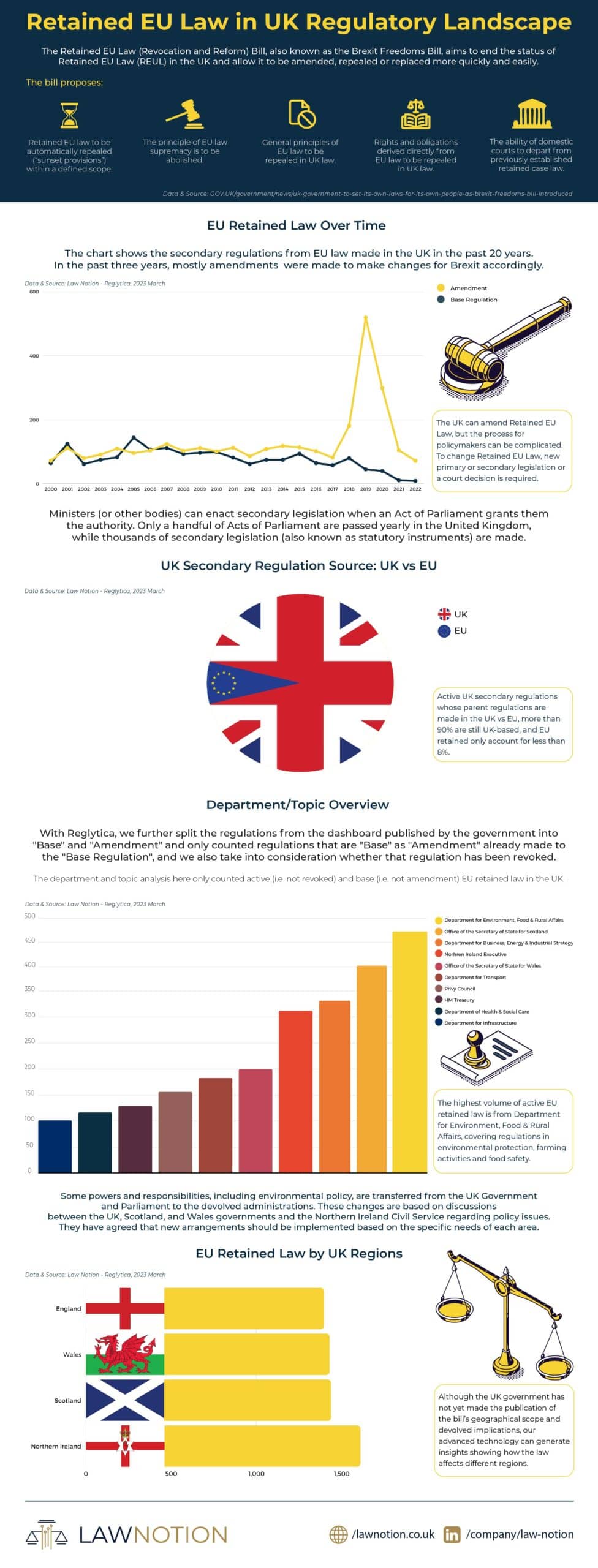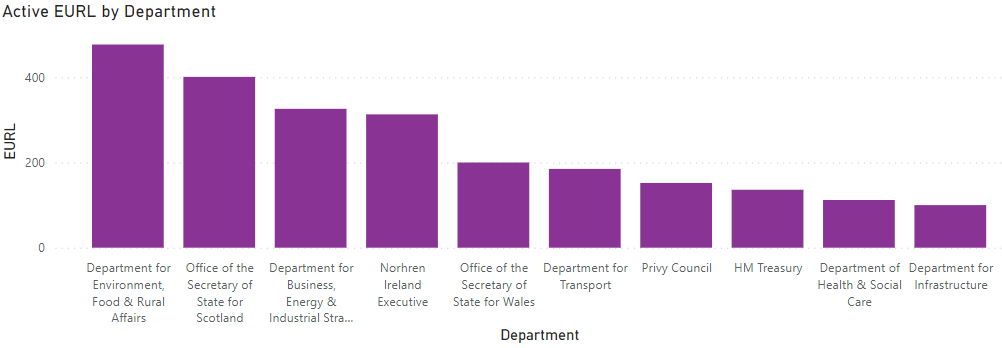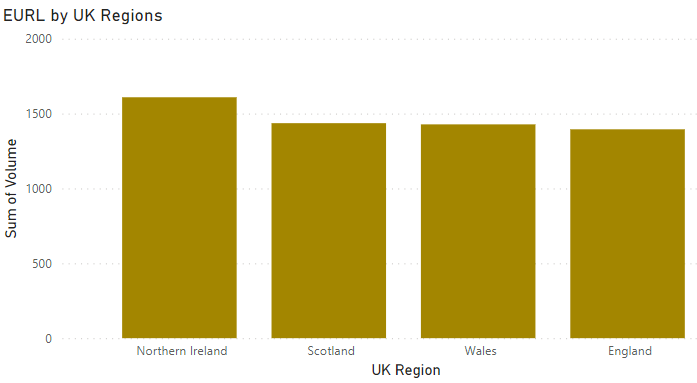
After the UK’s exit from the EU to facilitate the transition and reduce the enormous amount of work necessary to separate UK law from EU law, the Retained EU Law (Revocation and Reform) Bill was created, also known as the “Brexit Freedoms Bill.” The government published a report titled The Benefits of Brexit in January 2022, stating its intention to ensure that any retained EU law on the UK statute book meets the UK’s priorities for unlocking growth and is tailored for the UK market.
To ensure continuity and legal certainty, and to avoid an interpretative void, the European Union (Withdrawal) Act 2018 (EUWA) essentially took a snapshot of applicable EU law in force in the UK on 31 December 2020 and provided provisions on its interpretation.
What is Retained EU Law?
The Retained EU Law (Revocation and Reform) Bill is designed to end the status of Retained EU Law (REUL) in the UK and allow it to be amended, repealed, or replaced more quickly and easily.
- Retained EU law to be automatically repealed (“sunset provisions”) within a defined scope
- The principle of EU law supremacy is to be abolished
- General principles of EU law to be repealed in UK law
- Rights and obligations derived directly from EU law to be repealed in UK law; and
- The ability of domestic courts to depart from previously established retained case law
For specific categories of retained EU law, the sunset clause could be extended by UK ministers (but not devolved authorities) until 23 June 2026. Direct EU legislation that is retained will be “downgraded” so that it can be amended by secondary legislation, reducing parliamentary scrutiny of amendments. Parliament would have to pass primary legislation to amend retained direct principal EU legislation, which must go through a strict legislative process in the Houses of Commons and Lords before becoming law.
Retain EU Law Impact Overview
EU Retained Law Over Time
The UK can amend Retained EU Law, but the process for policymakers can be complicated. Since 1990, the UK has reportedly enacted over 50,000 laws due to its EU membership. To change Retained EU Law, new primary or secondary legislation or a court decision is required.
Any secondary EU law retained after 2023 will be available for ministerial restatement. When referring to retained EU law, the term “secondary retained EU law” is used to describe both retained EU law that is not primary legislation and retained EU law that is primary legislation but whose text has been inserted by secondary legislation. (The Bill defines “secondary retained EU law” as (a) any retained EU law that is not primary legislation and (b) any retained EU law that is primary legislation the text of which was inserted by subordinate legislation. “Secondary assimilated law” refers to the same categories of law, but after the end of 2023. See Retained EU Law (Revocation and Reform) Bill, clauses 6, 12(2) and 13(2).)
The below chart shows the secondary regulations from EU law made in the UK in the past 20 years. In the past three3 years, there have been fewer types of secondary regulations made while more amendments were made, which are most likely to make changes for Brexit accordingly

Ministers (or other bodies) can enact secondary legislation when an Act of Parliament grants them the authority to do so. There are only a handful of Acts of Parliament passed each year in the United Kingdom, while thousands of pieces of secondary legislation (also known as statutory instruments) are made.
Having experts prepare laws, the ability to adapt to new circumstances, and avoiding the waste of Parliamentary time on highly technical matters are all benefits of secondary legislation. There are also a number of drawbacks, including a lack of public debate and oversight and a massive amount of legislation being produced with little parliamentary scrutiny.
UK Secondary Regulation Source: UK vs EU
Currently, looking at the active UK secondary regulations whose parent regulations are made in the UK vs EU, more than 90% are still UK-based, and EU retained only account for less than 8%.

Department Overview
The government published the first version of the “Retained EU Law Dashboard” in June summer of 2022. It compiled over 2,400 pieces of legislation that it had identified as retained EU law in over 300 policy areas across 21 sectors of the UK economy.
Different from the dashboard published by the government, we further split the regulations into “Base” and “Amendment” and only counted regulations that are “Base” as “Amendment” already made to the “Base Regulation”, and we also take into consideration whether that regulation has been revoked.
The department and topic analysis here only counted active (i.e. not revoked) and base (i.e. not amendment) EU retained law in the UK. These methodological approaches using Law Notion -Reglytica provide a more detailed understanding of the impact of retained EU law on the UK compared to the government’s dashboard.
As shown in the below chart, the highest volume of EU retained law is made by Defra.

Topic Overview
Many other regulations of similar public importance can be found within the Defra body of REUL, regulations that aim to protect all aspects of our natural environment and many aspects of people’s health by establishing standards for things like water quality and bathing waters.
As shown in the below chart, corresponding with the department, the highest volume of EU retained law is about farming (e.g. animal keeping & production).

UK Regions Overview
Although the UK government has not yet made the publication of the bill’s geographical scope and devolved implications, our advanced technology can generate insights showing how the law affects different regions.
Data generated by Law Notion – Reglytica shows that the total volume of the law’s effects is relatively similar across the different regions of the UK. However, Northern Ireland is slightly more impacted by the law than other regions. These insights are valuable for understanding the impact of the EU Retained Law on the UK, especially for policymakers looking to improve UK regulations.
As shown in the below chart, Northern Ireland has the most EU- retained laws, while Scotland, Wales and England are very similar.

Final Thoughts
Brexit has had a significant impact on the regulation of the UK. The creation of the Retained EU Law (Revocation and Reform) Bill and the European Union (Withdrawal) Act 2018 were crucial steps taken to ensure legal continuity and avoid an interpretative void.
However, navigating the volume and impact of the retained EU law can be challenging for policymakers in the UK. Law Notion – Reglytica can help policymakers understand the implications of retained EU law and make better policy decisions. By providing in-depth analysis and insights, Reglytica can help policymakers tailor retained EU law to the UK’s priorities and ensure it unlocks growth for the country’s economy
